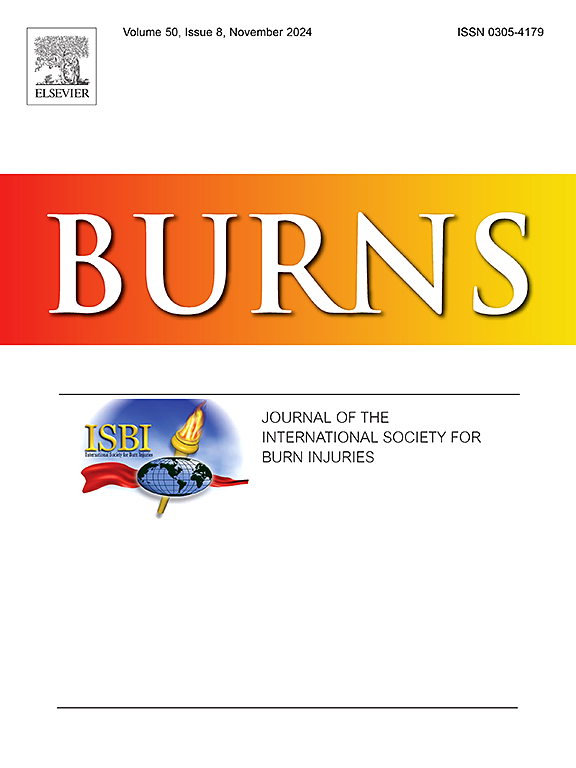“To BAL or not to BAL, that is the question”: Variations in smoke inhalation injury guidelines from burn units and centres in England, Scotland and Wales
IF 3.2
3区 医学
Q2 CRITICAL CARE MEDICINE
引用次数: 0
Abstract
Aim
To evaluate variations in diagnostic criteria and management recommendations for smoke inhalation injury (SII) amongst the burn networks of England, Scotland, and Wales.
Methods
A descriptive cross-sectional study examining SII guidelines provided by adult burn units and centres in England, Scotland and Wales.
Results
All 16 adult burn units and centres responded. Fourteen (87.5 %) had guidelines. Due to sharing of guidelines, ten unique guidelines were assessed. Diagnostic criteria showed variability with no universal criterion shared amongst guidelines. Bronchoscopy was recommended by 90 % of guidelines, but the timing varied. The use of bronchoscopic scoring systems was recommended by four guidelines. Bronchoalveolar lavage (BAL) was recommended by four, with considerable variation in frequency and choice of lavage fluid. All guidelines advised at least one nebulised agent: heparin (n = 8); N-acetyl cysteine (NAC) (n = 8); or salbutamol (n = 8). All guidelines included advice on carbon monoxide poisoning; however, carboxyhaemoglobin (COHb) cut-off levels for treatment varied (5 % [n-4], 10 % [n = 3], 15 % [n = 1]). All recommended high-flow oxygen. Seven (70 %) guidelines offered guidance on cyanide poisoning. Reduced/altered consciousness was the only consistent diagnostic criterion. Five (50 %) guidelines provided intubation guidance, emphasising the role of a ‘senior clinician’ as the intubator. Ventilatory guidance appeared in eight guidelines, focusing on lung protective ventilation (n = 8); oxygenation goals (n = 3); and permissive hypercapnia (n = 3). Within lung-protective ventilation, advice on tidal volume (6, or 6–8 ml/kg) and plateau pressures (>30 cmH2O) were presented most commonly (n = 7).
Conclusion
This study has outlined the substantial variations in guidance for the management of SII. The results underscore the need for a national guideline outlining a standardised approach to the diagnosis and management of SII, within the limitations of the current evidence.
"BAL 还是不 BAL,这是一个问题":英格兰、苏格兰和威尔士烧伤科和烧伤中心的烟雾吸入损伤指南存在差异。
目的:评估英格兰、苏格兰和威尔士烧伤网络在烟雾吸入伤(SII)诊断标准和管理建议方面的差异:方法:对英格兰、苏格兰和威尔士的成人烧伤单位和中心提供的 SII 指南进行描述性横断面研究:所有 16 个成人烧伤单位和中心都做出了回应。14个单位(87.5%)制定了指南。由于共享指南,因此评估了 10 份独特的指南。诊断标准存在差异,各指南之间没有共享的通用标准。90%的指南建议进行支气管镜检查,但时间安排各不相同。有四份指南推荐使用支气管镜评分系统。四份指南建议进行支气管肺泡灌洗(BAL),但在频率和灌洗液的选择上存在很大差异。所有指南都建议至少使用一种雾化剂:肝素(8 份)、N-乙酰半胱氨酸(NAC)(8 份)或沙丁胺醇(8 份)。所有指南都包含一氧化碳中毒建议;但治疗的碳氧血红蛋白 (COHb) 临界值各不相同(5% [n-4]、10% [n=3]、15% [n=1])。所有指南都建议使用高流量氧气。七份指南(70%)提供了氰化物中毒的指导。意识减退/改变是唯一一致的诊断标准。五份(50%)指南提供了插管指导,强调了 "资深临床医生 "作为插管者的作用。有 8 份指南提供了通气指导,重点是肺保护性通气(8 份)、氧合目标(3 份)和允许性高碳酸血症(3 份)。在肺保护性通气中,潮气量(6 或 6-8 毫升/千克)和高原压(>30 厘米水压)的建议最为常见(n = 7):本研究概述了在 SII 管理指导方面存在的巨大差异。研究结果表明,在现有证据的限制下,有必要制定一份全国性指南,概述 SII 诊断和管理的标准化方法。
本文章由计算机程序翻译,如有差异,请以英文原文为准。
求助全文
约1分钟内获得全文
求助全文
来源期刊

Burns
医学-皮肤病学
CiteScore
4.50
自引率
18.50%
发文量
304
审稿时长
72 days
期刊介绍:
Burns aims to foster the exchange of information among all engaged in preventing and treating the effects of burns. The journal focuses on clinical, scientific and social aspects of these injuries and covers the prevention of the injury, the epidemiology of such injuries and all aspects of treatment including development of new techniques and technologies and verification of existing ones. Regular features include clinical and scientific papers, state of the art reviews and descriptions of burn-care in practice.
Topics covered by Burns include: the effects of smoke on man and animals, their tissues and cells; the responses to and treatment of patients and animals with chemical injuries to the skin; the biological and clinical effects of cold injuries; surgical techniques which are, or may be relevant to the treatment of burned patients during the acute or reconstructive phase following injury; well controlled laboratory studies of the effectiveness of anti-microbial agents on infection and new materials on scarring and healing; inflammatory responses to injury, effectiveness of related agents and other compounds used to modify the physiological and cellular responses to the injury; experimental studies of burns and the outcome of burn wound healing; regenerative medicine concerning the skin.
 求助内容:
求助内容: 应助结果提醒方式:
应助结果提醒方式:


